.
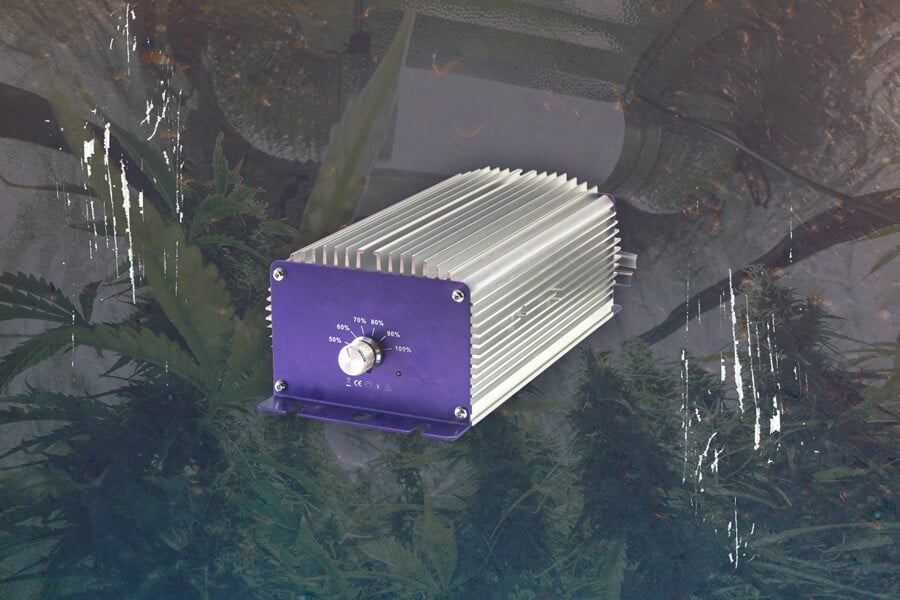
How to Select and Operate the Ballast for HID Growing Lamps
You've got a reliable HID lamp, a sturdy growing tent, some high-quality fans, and a trusty carbon scrubber. Your indoor grow setup is complete, right? Well, almost. They're not mandatory, but pairing a light ballast with your HID lamp offers a long list of benefits. You'll save on running costs and protect your light source!
When it comes to growing weed indoors, you need several key pieces of equipment to make things run smoothly. Even if you’ve never heard of a light ballast before, you should certainly consider installing one! It'll extend the longevity of your HID lamp while lowering running costs. Find out everything you need to know about ballasts below.
Contents:
What Are HID Ballasts and Why Are They Important?
If you’ve ever spent time browsing for grow lights, you’ll have come across high-intensity discharge (HID) lamps at some point. Although power-hungry and lacking longevity, many growers elect to use HIDs thanks to their reliability and capacity to produce excellent yields. However, many cultivators don’t use these lamps in isolation. To improve the efficiency and longevity of their setup, they also incorporate an in-line ballast.
What’s a ballast? We’re glad you asked! Lighting ballasts come in a variety of different forms, but they all serve the same purpose: to regulate the amount of electrical current that flows into a lighting system. HID lamps (metal halide and high-pressure sodium) produce light via an electric arc that reaches between two tungsten electrodes. A large initial surge in energy is needed to get things going. However, lamps only need a low and steady voltage once illuminated. Ballasts are used to maintain the appropriate voltage needed for effective illumination while protecting bulbs from excess current that can cause them to break or considerably reduce their lifespan.
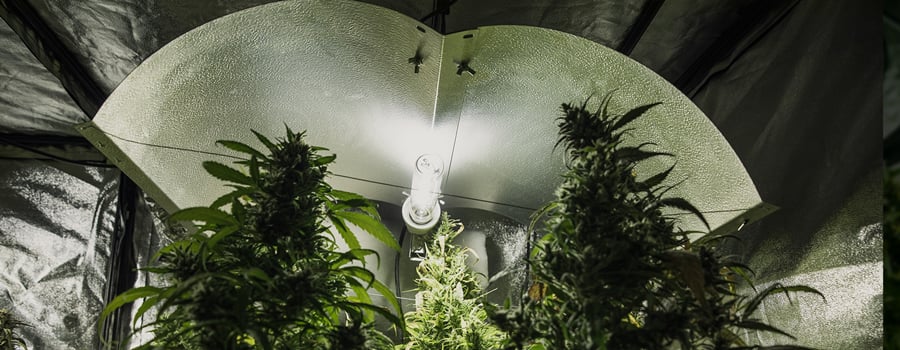
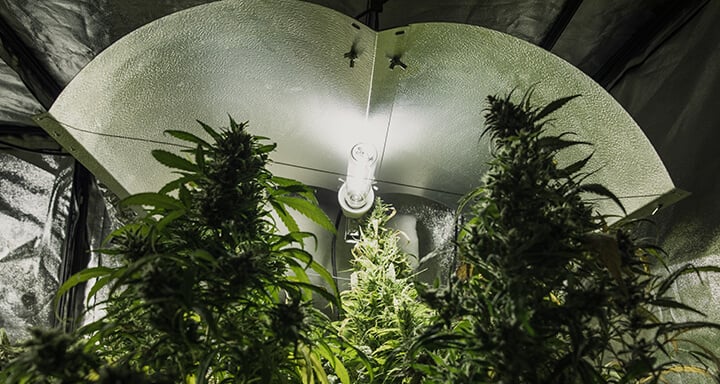
How HID Ballasts Work
You’re now aware of what a HID ballast does, congratulations! But how exactly do these useful pieces of kit work? You can think of ballasts as having a dual function. They serve up an initial jolt to turn the lamp on, akin to a kind of “boost mode”; then, they switch over to a “cruise control” in which they pull back the initial jolt of current and supply enough for a lamp to operate optimally—neither too dull nor too bright. Here’s how the whole process unfolds.
Connection
So, what happens when using both a HID lamp and a ballast to illuminate a cannabis growing room? Well, nothing at all unless you hook up your kit to the mains! To begin using this duo together, you’ll need to create a circuit using alternating current (AC) mains power.
Preheating
Before the ballast ignites the HID lamp, it needs to warm things up. It does this by sending a low-voltage current into the bulb that crosses the lamp’s electrodes. This low voltage preheats the system and vaporizes the xenon and metal salts in the lamp.
Ignition
After getting things warmed up, the ballast then gets the party started. During the ignition phase, it sends a high-voltage pulse from its internal igniter. This swift charge creates a spark, subsequently causing the vaporized gas within the lamp to ionise. This creates a powerful illuminating arc of light.
Voltage Regulation
After this initial surge of energy, the ballast draws back the amount of voltage flowing into the bulb. This regulatory function creates stable and efficient illumination, and also prevents bulbs from overheating and breaking. It’s important for growers to choose a ballast compatible with the specifications of their lamp to ensure it can do its job properly.
Thermal Protection
Many of the HID ballast models available feature thermal protection mechanisms that protect the ballast itself. As well as preserving the bulb for as long as possible, these ballasts modulate the current they draw, or even shut down entirely, to prevent overheating and damage.
Shutdown
When you hit the switch to your main supply, or your timer cuts the circuit for you, the ballast in your circuit will stop providing power to the lamp. Your HID lamp will cool down and wait patiently for you to start the cycle all over again!
What Are the Main Types of Ballast?
You know what HID light ballasts are and exactly how they work! Next up, you need to know what to look for when shopping around for a good ballast. There are two main types of ballast: magnetic and electronic. Discover the differences between them below, as well as their unique advantages and disadvantages.
Magnetic Ballasts
Magnetic ballasts are older and more simple than their electronic counterparts. These devices use electromagnetic induction to control the current flowing toward the bulb. Here are some of their key characteristics.
- Simple design: Magnetic ballasts are both reliable and durable. Their simple design is time-tested. Many growers choose magnetic ballasts simply because they have been proven to work well.
- Cost-effective: Magnetic ballasts are generally older than electronic versions and are made of less-complex and less-expensive components. Because of this, they are much easier on the bank account when it comes to purchasing one. If you’re limited by your budget when it comes to growing weed, opting to include a magnetic ballast in your circuit will save you a few quid outright.
- Less efficient: Naturally, as an older form of tech, magnetic ballasts are less efficient than modern electronic versions. Not only do they make more noise, and therefore potentially compromise the stealth of your growing hobby, but they cost more to run. Sure, you’ll save some money during the transaction, but you’ll spend more on electricity costs in the long term.
- Bulky: Do you remember what phones looked and felt like in the early 2000s? What about the monolithic models of the 1990s? Technology becomes more compact yet more complex with time. The same principle applies to HID ballasts. Older models are larger, heavier, and more clunky.
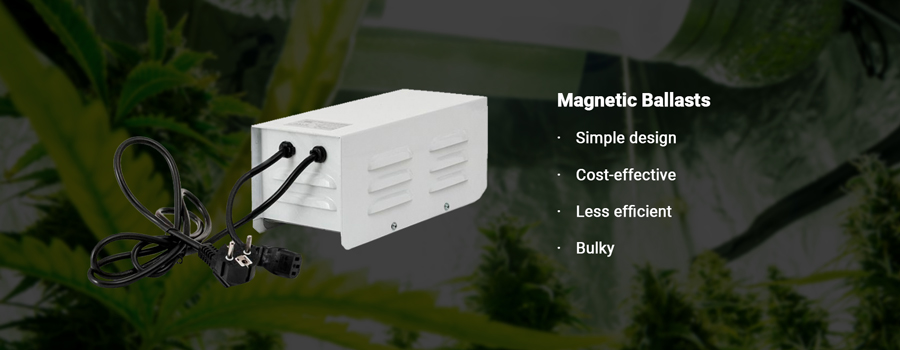
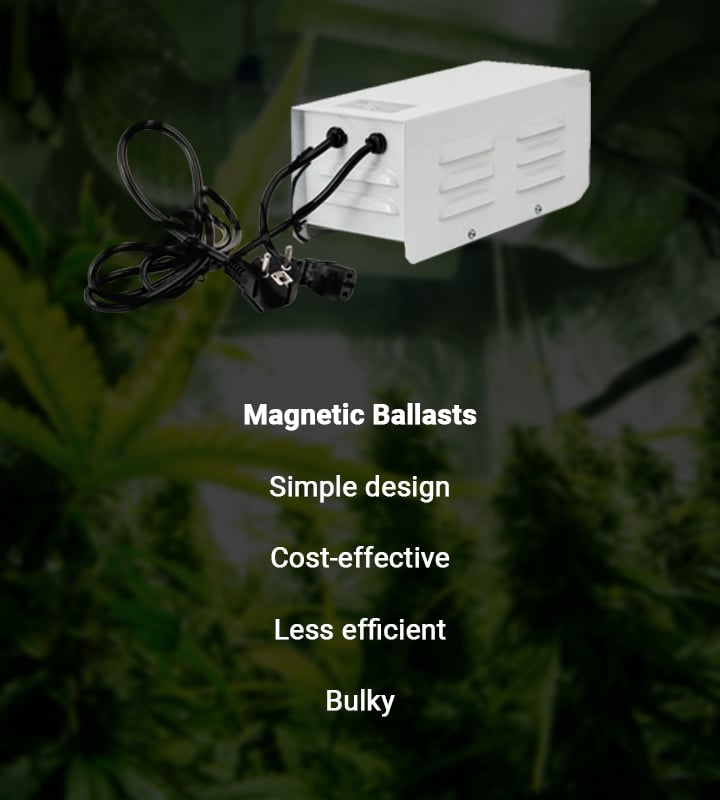
Electronic Ballasts
When it comes to HID lighting for cannabis cultivation, electronic ballasts are the most advanced and efficient option. Also known as digital ballasts, they contain microprocessors to regulate and monitor the voltage a bulb receives. Get acquainted with their most important features below.
- Small and light: Compare the latest iPhone with the brick phones of decades past. Electronic ballasts are smaller, lighter, and more streamlined. They are less likely to fall from ceiling fixtures and squish your plants, and they’re also easy to pack up and carry if you’re somewhat of a nomadic indoor cultivator.
- Superior efficiency: Efficiency matters when putting together your indoor growing setup. Not only does efficient equipment reduce running costs, but it’s very often of higher quality and lasts longer. Electronic ballasts require more of an initial investment, but they offer more bang for their buck. Their superior efficiency means they consume less energy while being able to channel a more consistent flow of voltage to your HID lamps.
- Reliable: Magnetic ballasts certainly work, but they’re notoriously clunky and oftentimes unreliable. The current they hold fluctuates, which causes HID lamps to frequently flicker. In contrast, electronic ballasts reduce the chances of bulb failures and are a much safer option when leaving your growing space for several days at a time.
- Controller compatibility: Many growers cultivate weed indoors with the idea of automating the grow. This hands-off method of growing weed reduces the workload while improving the results. Electronic ballasts are perfect for this approach as many are compatible with external controllers and timers.
- Dimming capability: Many electronic ballasts are equipped with a dimmer switch that gives the cultivator much more control over the power output of their lamps. This allows growers to fine-tune the amount of light needed for the lumen and PAR requirements of their space while enhancing the longevity of their HID lamps.
- Longer lifespan: Electrical ballasts have a longer lifespan than older magnetic models. Increased longevity decreases the frequency of inevitable replacement costs. On top of this, these models also do a better job of prolonging the lifespan of HID bulbs themselves.
- Quiet: As well as constant flickering, magnetic ballasts emit a constant and rather annoying hum. Not only can this sound intrude upon the peace and tranquillity of a growing tent, but it can also give the game away if you need to be extra stealthy when growing the herb. Not the case with electronic ballasts!
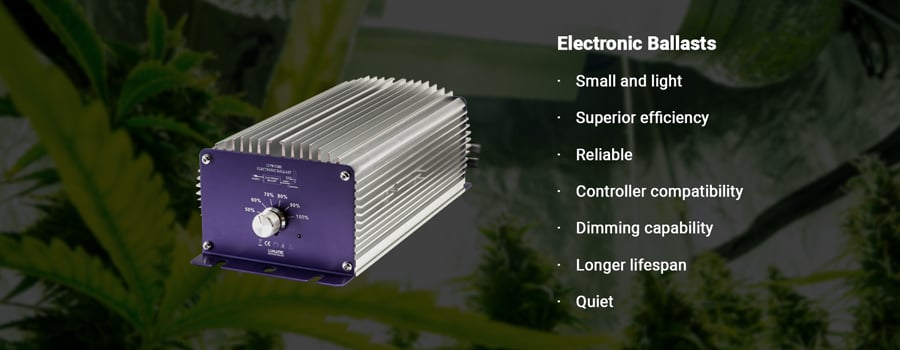
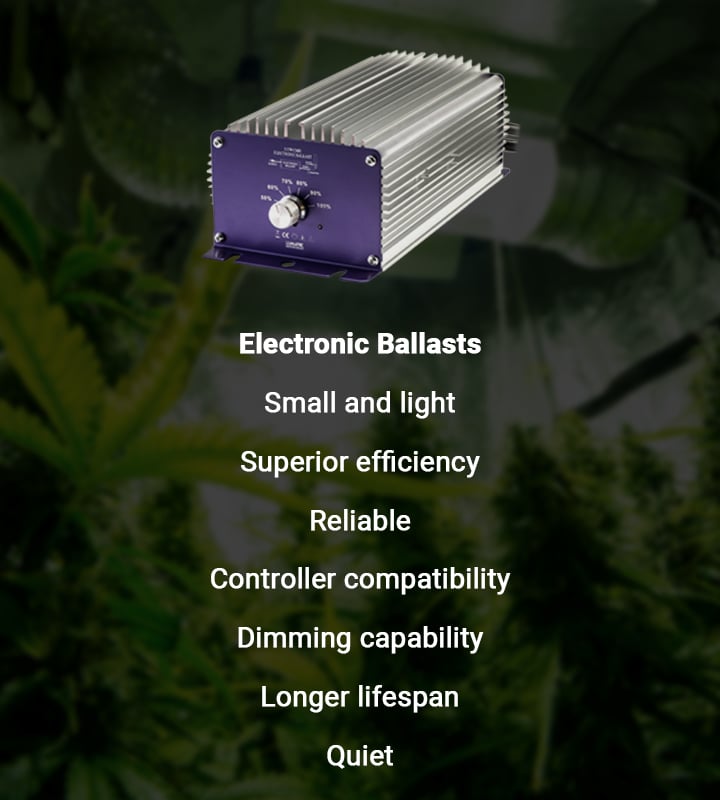
How to Select the Best Ballast for HID Grow Lights
Electronic ballasts certainly boast more benefits than magnetic, but they’re not the right choice for every grower. To determine which type will work best for you, carefully consider the following factors.
How to Connect HID Ballasts
After selecting which ballast is right for your growing operation, you need to set it up! Follow the simple instructions below to get it up and running in no time.
- Know your components: Become familiar with the pieces of equipment that contribute to your HID setup, including your bulb, ballast, and any reflectors. Make one final check to ensure you have a compatible lamp and ballast.
- Power off: Before you go any further, you need to make sure the power supply to your HID lamp is off.
- Mount your ballast: Securely mount your ballast, lamp, and reflector in your growing tent. Place it in a well-ventilated spot and at a good distance from any surface.
- Connect wires: Follow the manufacturer's instructions to make sure you’ve secured the correct connections in your circuit.
- Regular inspection: Routinely inspect your lamp and ballast, and secure any loose connections.
HID Light Ballasts: Often Overlooked But Still Important
And just like that, you’re a HID ballast light expert! You know what ballasts are and how they work, and you’re aware of the different types available. You even know how to hook one up to your HID lamp. So, will you go ahead and harness the power of ballasts to save on electricity costs and prolong the longevity of your HID lamp?









































